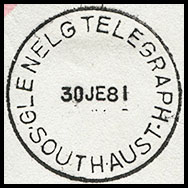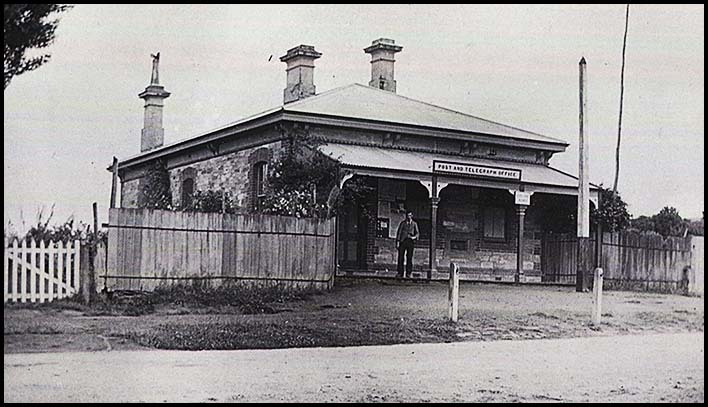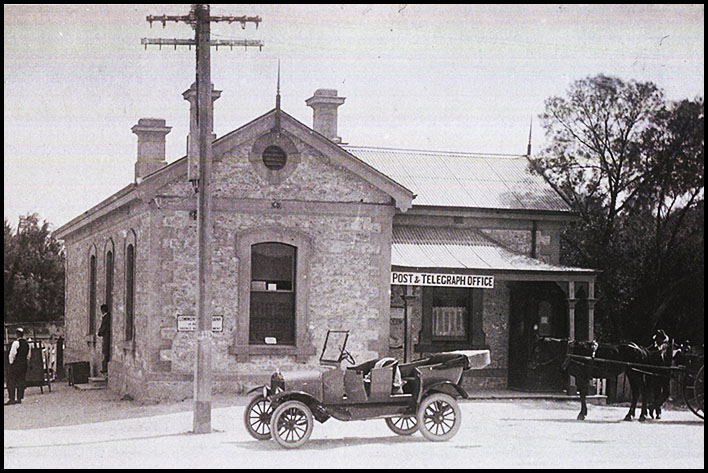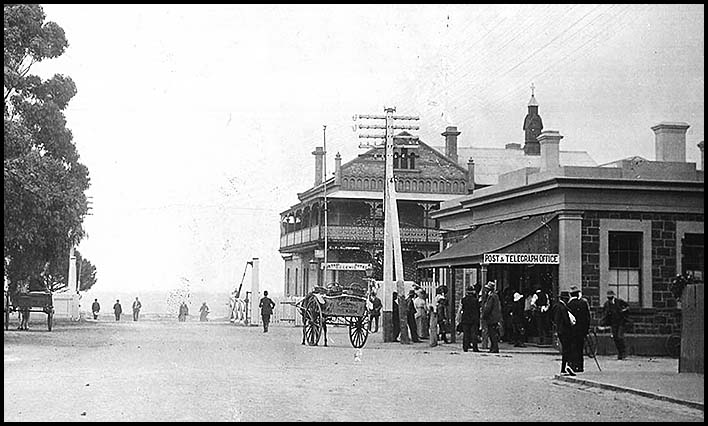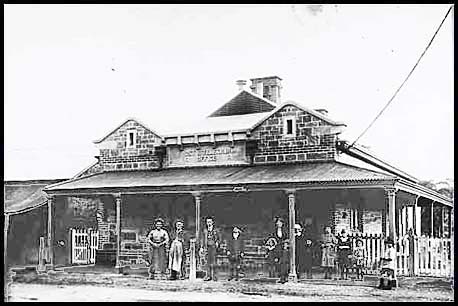Telegraph Offices in the Glenelg - Cape Jervis - the Coorong region.
- Home, index, site details
- Australia 1901-1988
- New South Wales
- Overview of NSW
- Telegraph lines
- Telegraph Offices
- Date stamps
- Forms
- Envelopes
- Rates
- Stamps
- Queensland
- Overview of Qld
- Telegraph lines
- Telegraph offices
- Date stamps
- Forms
- Envelopes
- Rates
- Stamps
- South Australia
- Overview of SA
- Telegraph lines
- Telegraph Offices
- Date stamps
- Forms
- Envelopes
- Rates
- Stamps
- Tasmania
- Overview of Tasmania
- General developments
- Reports
- Organisation
- Telegraph lines
- Telegraph Offices
- Date stamps
- Railway lines
- Forms
- Envelopes
- Rates
- Stamps
- Overview of Tasmania
- Victoria
- Overview of Vic.
- Telegraph lines
- Telegraph offices
- Date stamps
- Forms
- Envelopes
- Rates
- Stamps
- Ephemera
- Western Australia
- Overview of WA
- Telegraph lines
- Telegraph Offices
- Date stamps
- Forms
- Envelopes
- Rates
- Stamps
| Aldinga | Brighton | Cape Jervis | Clarendon | Coromandel Valley | Glenelg | Goolwa | Meadows |
| Milang | Morphett Vale | Port Elliott | Noarlunga | Normanville | Victor Harbour | Willunga | Yankalilla |
|
In the House on 13 November 1867, "Mr. Colton presented a petition from 44 residents of Aldinga, praying that a sum of £250 should be appropriated towards the erection of a Telegraph Station in that township". The Post & Telegraph Office opened on 18 December 1874. Mrs. Machel - formerly of the Normanville Office - was in charge. The Minister of Education had told a deputation on 11 July 1873, that money had been voted for a Post & Telegraph Office and that construction would start when a site had been decided upon. Work began at the end of March 1874 - the site being opposite the Aldinga Hotel". On the completion of the Office, the Weekly Chronicle of 3 October 1874 said
FINALLY!!!!!!!!
|
|
|
The Telegraph Office opened at Brighton - just to the south of Glenelg - on 26 September 1880 - although the opening was not officially announced until 1 October.
|
|
The Telegraph Station opened in April 1873. A change of classification to Post and Telegraph Office was made in November 1873. Residents around Cape Jervis - many occupied with developing the tin and lead mines starting in the area - were about 21 miles from Yankalilla. With no facilities there, they had to come to Yankalilla to send messages and to seek legal counsel especially to settle disputes . |
|
|
The Telegraph Office opened on 7 June 1879 - the same day as that for Coromandel Valley. In September 1878, " there was a prospect of our long-talked of telegraph line being commenced. It has been pegged and surveyed and tenders called for its construction". The South Australian Registered of 31 May 1879 brought the news that "We are daily expecting now to hear when the Telegraph Office will be formally opened. The building is quite completed and some of the operator's goods have arrived". |
|
The Telegraph Office was opened on 7 June 1879 the same days as that for Clarendon. On 29 May 1877, there was a note saying "We were pleased to note that the deputation as to a Telegraph Station here was so favorably received by the Government. A station would be a great boon to this place." The South Australian Advertiser of 11 March 1878 reported that " The Government have not taken any steps towards the erection of our Post Office and Telegraph Station, although the amount for the work was passed some time ago". Then on 27 July the South Australian Chronicle reported "I am glad to be able to say that the Government have at last taken the initiatory step towards our long-promised Telegraph Station and Post Office by purchasing a site, but whether the line will come via Coromandel Valley or tap the southern line at Reynella is not yet known". The South Australian Register of 19 March 1879 (p. 2) reported "The work of building the Telegraph Station and Post-Office is proceeding rapidly. The roof is now being put on and, as the contractor hopes to have the work finished by the middle of next month, and the line of wire being completed, we hope to reap the convenience of telegraph communication very shortly". |
|
| Glenelg.
The Telegraph Office opened on 3 September 1859. On 1 August 1861, a group of 38 residents petitioned the House for the Post Office to be removed to the Telegraph Office. A large new office was constructed in 1880 which included additions to the residence. The cost was £828. In 1902 a cable station was opened at/near Glenelg as the shore station for the Cape-Cottesloe-Glenelg submarine cable. |
|
 Glenelg Post & Telegraph Office about 1880. Presumably this was the building which had just been constructed. |
|
 Glenelg Post & Telegraph Office about 1911. A newer building. TELEGRAPH can be seen above the right hand door. |
|
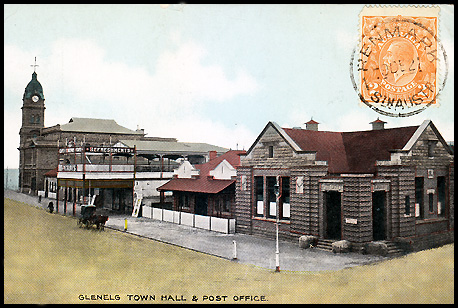 Glenelg Post Office and Town Hall in early 1900s. |
|
Early postal date stamps began to be used on telegrams. Those for Glenelg were framed.
The example shown to the right is the earliest use of a |
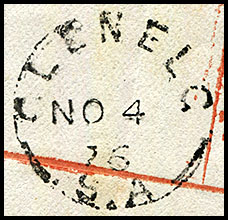 4 November 1876. Used on SC-DO-4A. |
A steel circular TELEGRAPH date stamp (RC1 - T) was used at Glenelg.
|
|
|
The Telegraph Office opened in 1857 in its own building (which is now the Goolwa Visitor Information Centre). The Post Office had opened in 1854 and the original building is still used as the Post Office. It is the oldest Post Office building in the State still is use. It was made from travertine limestone with a hipped shingle roof. |
Also in 1854, a horse-drawn tramway to Port Elliot began operation which, from 1859, used the verandah of the Post Office as the tram stop. That was an obvious place because the tram had to collect and deposit mail. See complete details in the excellent report written by Carol Cosgrave. At one stage in 1886, a correspondent described Goolwa as having "a little (train) platform and shed in the middle of a wide deserted street. An irregular and antique looking Post and Telegraph Office stands opposite on a triangular section". |
|
The Post and Telegraph Office was opened at Meadows on 1 August 1884 by the Deputy Postmaster-General. It was described as "a really very handsome building" and everyone was pleased with the opening of the line of telegraph. Miss Champion was in charge. The Post Office at Meadows had opened on 18 July 1850. It then closed on 29 February 1852 but was relisted as a Post Office on 1 January 1855. Telephone facilities were established in May 1900. The Advertiser of 21 January 1910 printed a damning report about the operation of the Meadows Post and Telegraph Office. |
|
|
The Post and Telegraph Office opened on 12 November 1883. The tender for the Telegraph Office had been let on 23 June to G. Sara & Co. for £719 6s 6d. Miss King was transferred there after the P&T office at Mount Torrens was closed on 1 April 1886 due to severe budget restrictions and enabling the department to save £90 per year. She was at Morphett Vale until her promotion to the Adelaide Office on November 1895. By 1906, Morphett Vale was the telegraphic centre for five postal districts - Hackham, Reynella, O'Halloran's Hill, Happy Valley and Horndale. Changes being introduced allowed the office to close from noon to 2:00 pm and they also stopped delivery of telegrams. A public meeting at the end of June passed the following resolution: "That this public meeting of residents in the postal and telegraph districts of Morphett Vale, Hackham. Reynella. O'Halloran Hill, Happy Valley, and Horndale desires to emphasize the serious injury and inconvenience occasioned by the adoption of the new regulations which close the Morphett Vale Post and Telegraph Office between the hours of 12 and 2 p.m. and for the day at 6 p.m.; and also the cessation of delivery by messenger, of telegrams received at Morphett Vale — the only telegraph office in the districts named". |
|
The Telegraph Office opened in 1857. The name is occasionally also written as "Port Elliott". The Post Office had opened in May 1852. |
|
Unframed Port Elliott date stamp. Used on a 2d orange de La Rue (perf 10) with a rare S.T. (Superintendent of Telegraphs) overprint in black. |
 1 September 1872 |
|
The Adelaide Observer of 3 June 1865 reported that "Mr. Colton presented a petition, signed by 34 persons in the district of Noarlunga, praying that the House would vote a sufficient sum for erecting a telegraphic station in the township of Noarlunga". The telegraph line opened on 5 April 1866. Charles Todd opened the line and used a portable battery he had brought with him to send the usual congratulatory messages as well as a few private telegrams. The officer in charge of the Railway Telegraph Station was responsible for the instrument. In 1871, the Post Office was relocated to the Telegraph Station so that the two branches could be combined. On 19 August 1891, £650 was gazetted for a new P&T Office - and this building was opened on 30 August 1892. |
|
|
The Adelaide to Normanville telegraph line was completed on 22 September 1862. The Telegraph Office opened in 1863 when the Telegraph Office in Yankalilla was transferred to Normanville. |
|
|
Willunga was the first station on the No. 1 line from Adelaide to Victoria. Hence a Telegraph Office was opened at Willunga in 1857. It was also a main repeater station for that line. The Post Office had opened on 14 July 1839 at the Police Station and was one of only six post offices which had been opened prior to 1841. It was moved to a separate building in August. Nevertheless the police were still in charge of mails until 1850. A telephone connection was established between Willunga and Aldinga on 4 September 1888. In a debate in the House on 5 August 1861, Mr. Blyth noted that "he did not think agriculturists were likely to make use of the telegraph. He had nothing to do with the building of the Willunga Station". |
|
| Willunga circular date stamp.
Diameter: 30 mm. Used on 1d Roo. |
 24 October 1913. |
